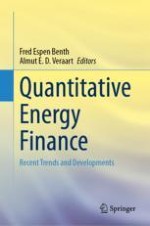2024 | OriginalPaper | Buchkapitel
Climate Risk in Structural Credit Models
verfasst von : Alexander Blasberg, Rüdiger Kiesel
Erschienen in: Quantitative Energy Finance
Verlag: Springer Nature Switzerland
Aktivieren Sie unsere intelligente Suche, um passende Fachinhalte oder Patente zu finden.
Wählen Sie Textabschnitte aus um mit Künstlicher Intelligenz passenden Patente zu finden. powered by
Markieren Sie Textabschnitte, um KI-gestützt weitere passende Inhalte zu finden. powered by
